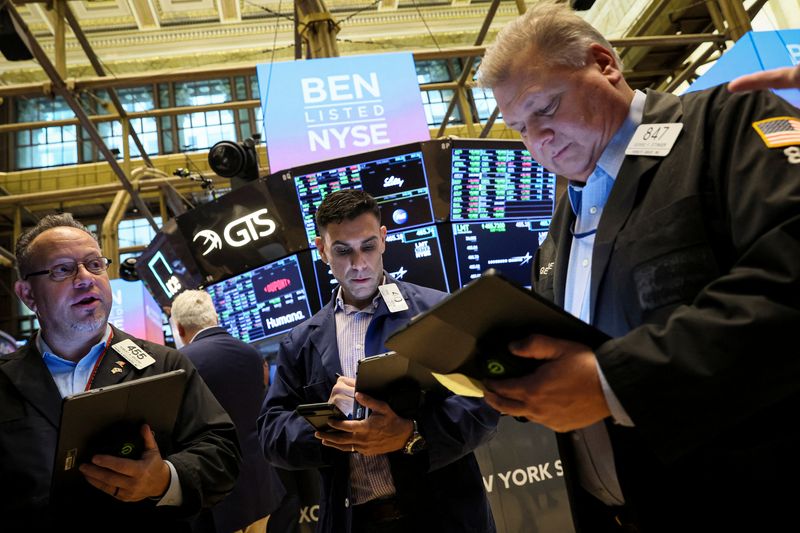By Saqib Iqbal Ahmed
NEW YORK (Reuters) - As U.S. stocks test the top of a range that has held for months, two widely used analytical styles appear to be painting conflicting scenarios for where they might go next.
Technical indicators such as equity price movement largely show stocks are poised to continue a rally that has seen the S&P 500 climb 8% year-to-date, analysts who track them said. Many investors who look to fundamentals, on the other hand, see choppy waters ahead when they study measures like corporate earnings and valuations.
Few market participants lean entirely on one style and neither approach is foolproof. Investors say the recent divergence, however, illustrates the wide range of outcomes faced by markets this year as they stare down a spate of thorny issues, from a possible recession to whether stocks have factored an expected slide in corporate earnings.
"This is the first year in a long time that technicians are sort of diverging from the fundamental or macro analysts," said Mark Newton, global head of technical strategy at Fundstrat Global Advisors.
"Everybody is very, very negative," but from a technical perspective, the market looks good, he said.
TECHNICALLY SPEAKING
The S&P 500 has traded in a 9.7 percentage point range year-to-date, its narrowest range for comparable periods since 2017. With the index now at around 4,133 and about 16% above its October lows, technicians see evidence it can extend its gains.
"This market is probably going to be stronger than a lot of people think," said Craig Johnson, chief market technician at Piper Sandler.
Johnson, who has a year-end S&P 500 target of 4,625, is encouraged by the reversals in downtrends for many U.S. stock indexes. In another bullish sign, the 50-day moving averages for several indexes are trading above their 200-day averages, signaling strength for the intermediate-term, he said.
GRAPHIC: Trend is a friend https://fingfx.thomsonreuters.com/gfx/mkt/zgvobzwejpd/Pasted%20image%201682023246352.png
Many technicians also say the market’s year-to-date resilience bodes well for stocks. The S&P 500 has traded higher 83% of the time for the full year, returning an average 13.73%, when it hasn't dropped below the preceding year’s December low in the first quarter, a Piper Sandler analysis showed.
Paradoxically, some technical analysts are also heartened by the amount of pessimism remaining in the market, believing good news can push sidelined investors into stocks - a dynamic that drove several sharp rallies last year.
Sentiment in a Bank of America (NYSE:BAC) (BofA) survey of global fund managers dipped to its lowest level this year in April, a development the bank said was "contrarian supportive for risk assets." Deutsche Bank’s measure of equity positioning for various types of investors remained well below neutral last week.
"Broader institutional positioning is still very bearish," Fundstrat's Newton said. "For me, that is a very big positive."
Not all technical indicators are rosy, though. A recent JPMorgan (NYSE:JPM) report noted the market's "underwhelming breadth," with this year's gains mostly driven by a handful of megacap stocks.
NOT SO FAST
There is also less optimism on the other side of the spectrum.
Patrick Kaser, head of the fundamental equity team at Brandywine Global, is preparing his portfolios for a potential U.S. recession by reducing exposure to economically-sensitive sectors such as financials and industrials.
While the market has lately tended to rally on bad economic news on expectations it could lead the Fed to cut rates sooner, Kaser believes investors will eventually see weak data as evidence of an approaching recession that could hurt stocks.
"The market ... doesn't appear to be pricing in earnings declines and higher unemployment" that would accompany a recession, he said.
The first batch of first-quarter corporate results have been mixed, with disappointing reports from Tesla Inc (NASDAQ:TSLA) and AT&T (NYSE:T) and upbeat numbers from several financial behemoths including Bank of America.
David Lefkowitz, the head of equities Americas at UBS Global Wealth Management, is worried about valuations. The S&P 500 is trading at about 18 times 12-month forward earnings estimates compared to its long-term average P/E of 15.6 times, according to Refinitiv Datastream.
"The risk/reward doesn't look great," said Lefkowitz, who has a year-end target of 3,800 for the index.
GRAPHIC: Stocks get pricier https://fingfx.thomsonreuters.com/gfx/mkt/gkplwamygvb/Pasted%20image%201682024169388.png
Analysts at JPMorgan sounded a similar note.
“Even in an optimistic scenario of soft landing … equity upside is likely less than 5% and that is the return that is delivered by short-term fixed income,” they wrote in a report earlier this week. “On the downside, even a mild recession would warrant retesting the previous lows and result in 15%+ downside.”
Meanwhile, BofA’s survey showed a near-peak 86% of investors bracing for "stagflation" - a blend of weak growth and inflation that has hurt asset prices in the past.
Even some bullish investors are prepared for rough seas as markets digest earnings and await the Fed meeting on May 1-2.

Nancy Tengler, chief investment officer for Laffer Tengler Investments, has recently added to positions in companies including Microsoft (NASDAQ:MSFT) and Adobe (NASDAQ:ADBE).
"It could be pretty choppy," she said, referring to the market's performance into May. "Then we begin phase two of working our way out of this bear market."